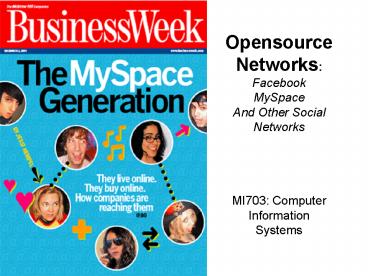Examples of Social Network Analysis - PowerPoint PPT Presentation
1 / 21
Title:
Examples of Social Network Analysis
Description:
Kevin Bacon Game (oracleofbacon.org) Social Network Analysis: ... What do social networks have to do with business? High Tech Company: Red = Married ... – PowerPoint PPT presentation
Number of Views:29
Avg rating:3.0/5.0
Title: Examples of Social Network Analysis
1
Opensource Networks Facebook MySpace And Other
Social Networks MI703 Computer Information
Systems
2
Takeaways
- A brief introduction into the science behind
social networks - The differences between formal and informal
organizational structures - How companies are using social networks to
improve their organizations. - Basic principles and laws behind social netoworks.
3
Organization Chart the Formal Organization
4
Social Networks the Informal Organization.
5
The new science of networks
- How well does an organization chart describe
organizations? - Formal vs. informal organizations.
- Six-degrees of separation. Famous 1948 study.
- Kevin Bacon Game
- (oracleofbacon.org)
6
Social Network AnalysisFocus on interactions
between individuals/ groups
Node Any entity in a network (person, system,
group, organization)
Tie Relationship/ interaction between two nodes.
7
Tie Strength
- Tie Strength How often and well two nodes
relate. - 2 types weak (acquaintances) strong (family).
- Which are better?
- Weak ties more of them with unconnected others,
better for finding jobs - Strong ties less of them with related others,
better for trust.
8
Network Density
- The number actual ties compared to the number of
possible ties - High density
- redundant
- error resistant
- high trust
- knowledge exploitation
- Low density
- more efficient
- specialized
- knowledge exploration
9
Centrality
- Where the node is situated in the network.
- Lots of different ways to define centrality.
Which node is most central in the above network? - Centrality associated with benefits power,
promotions, influence
10
So what, Jerry?
- What do social networks have to do with business?
11
High Tech Company Red Married Blue Single
12
Protestant Ministers (Red Female Blue
Male)
13
Protestant Ministers Blue Minority, Red
Majority, Black Unknown
14
Healthcare Teams 1) Doctors vs. Nurses Evenly
distributed (top) vs. Clustered (bottom). 2)
Density of Network/ Relationships Sparse (top)
vs. Dense (bottom). 3) Position of systems
around network Equally distributed (top) vs.
Unbalanced (bottom) 4) Distance of systems from
network Close (Cerner) vs. Distant (PCR)
Team A
Team B
Key Grey Systems Red Nurses Blue Doctors
15
Most popular blogs (by inbound links)
16
Network Roles
- Central Connector person who holds network
together. - Peripheral Specialist person on outside of
network with particular skills. - Boundary Spanner person who brings two networks
together. - Information Broker person who transmits
knowledge from one side of network to another.
17
Your social networks
- Do you have fewer strong ties or more weak ties?
- Are your networks comprised of similar or
dissimilar people? - Is your network dense or sparse? How does this
help or constrain you? - Are you central or peripheral? In which networks?
- Are you a boundary-spanner?
18
Open Source Knowledge Creation
- Open source creating intellectual property and
giving it away for free. - Why are people doing this?
- For the joy of creation
- Because its easy
- For people to give them stuff in the future
- Give it away until they find some way to make
money off it.
19
Open source software
- Linux
- Operating System created by Linus Torvalds.
- GPL (General Public License)
- Software itself is free
- Any additions to the kernel have to be free
- Can charge for services/ software on top of it
(Red Hat, IBM). - Today Not really volunteers, professionals
tasked to work on Linux. Why?
20
Opensource and Networks
- Network position and knowledge creation
- Centrality access, timing, referral
- Peripheral creativity
- Linux community intentionally cultivates
core-periphery structure - Torvalds, Lieutenants, Others.
- Wikipedia cultivates similar structure (1 of
users make most of contributions)
21
Takeaways
- A brief introduction into the science behind
social networks - The differences between formal and informal
organizational structures - How companies are using social networks to
improve their organizations. - Basic principles and laws behind social netoworks.































